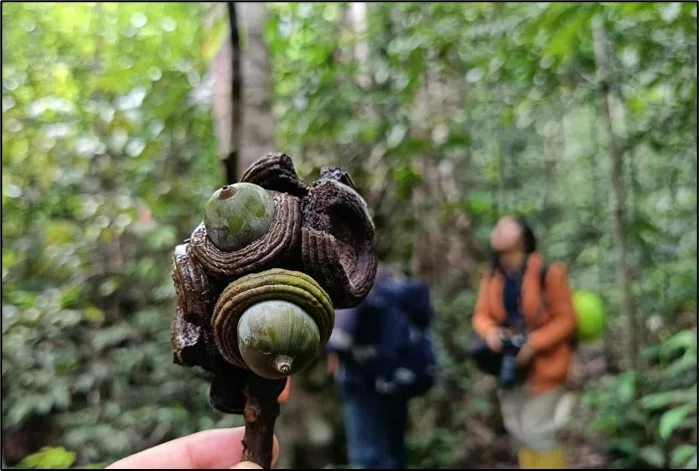Geseng, scientifically known as Quercus gammeliflora, is a tree species belonging to the Fagaceae family, or the oak family. It naturally grows in tropical mountain forests across Southeast Asia, including Indonesia, particularly at altitudes between 800 and 2,000 metres above sea level. The tree thrives in cool, high-rainfall regions such as the mountain ranges of Sumatra and Java. Its presence often serves as an indicator of a well-preserved montane ecosystem.
Geseng has a large and sturdy trunk that can grow up to 25–30 metres tall, with a diameter exceeding 60 centimetres. Its bark is dark brown to greyish in colour, coarse in texture, and marked by natural fissures. The leaves are oblong to elliptical with finely serrated edges, a characteristic feature of oak trees.
The fruit is a small, hard, rounded nut that serves as an important food source for wildlife such as squirrels, birds, and wild boars. This makes Geseng a vital link in maintaining the food chain within the mountain forest ecosystem.
Quercus gammeliflora is widely distributed across Southeast Asia — from Myanmar, Thailand, Laos, and Vietnam to western Indonesia. In Indonesia, it is commonly found in humid montane forests, often growing alongside other mountain tree species such as Castanopsis and Lithocarpus.
The presence of Geseng in an area often signifies fertile soil, good drainage, and healthy vegetation cover. As such, the species also serves as an ecological indicator of balanced and sustainable forest ecosystems.
Geseng plays an essential role in maintaining environmental balance:
- Natural carbon absorber: With its dense canopy and long lifespan, Geseng can absorb large amounts of carbon dioxide, helping to mitigate the effects of global climate change.
- Erosion control: Its strong root system anchors the soil on slopes, preventing erosion and landslides.
- Habitat provider: The tree’s lush canopy provides shelter for numerous species of birds, insects, and small mammals.
- Groundwater preservation: The layer of fallen leaves beneath the tree acts as natural mulch, helping retain soil moisture and slow down surface water runoff.
Through these ecological functions, Geseng serves as a lifeline species for the mountain ecosystem.
Beyond its ecological significance, Geseng provides tangible benefits for communities living around forest areas:
- High-quality timber: Its wood is hard, dense, and resistant to termites and fungi, making it ideal for furniture, flooring, door frames, and heavy construction.
- Natural energy source: In some regions, Geseng wood is used to produce premium charcoal due to its high calorific value and steady combustion.
- Conservation species: Geseng is often planted in mountain forest rehabilitation programmes because of its strong adaptability and vigorous growth.
- Cultural and traditional value: In several indigenous communities, the tree is regarded as a guardian tree and is used in traditional ceremonies or to make musical instruments.
Geseng is far more than an ordinary mountain tree — it is a guardian of ecological balance, a source of economic value, and a cultural treasure of great importance. Wise utilisation and sustainable conservation efforts will ensure that Quercus gammeliflora continues to thrive as a symbol of harmony between humanity and nature.
By protecting Geseng, we are in fact safeguarding the earth’s lungs and preserving a vital natural heritage for future generations.







